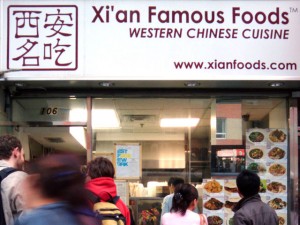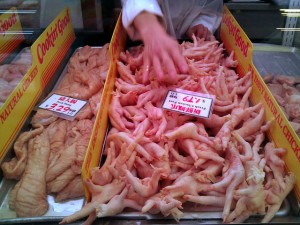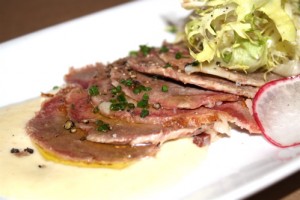By Perry Santanachote
Whether it’s the caramelized sweetbreads at Jean-Georges, the pig foot Milanese at Babbo or the braised tongue omelet at Prune, dishes featuring offal, the bits of beasts that in the past have been discarded by Westerners, are now the starlets on five-star menus.
Offal may be new and exciting for many Americans who grew up in the homogenized grocery store culture, but a lot of ethnic communities consider it everyday fare. Whether it’s because offal cuts are cheaper or because the texture is prized, nearly every culture – aside from traditional American – loves its blood and guts.
Walk into any hole-in-the-wall joint in Chinatown or Flushing where offal isn’t a buzzword and you’ll find congee with cubes of blood, hand-pulled noodles in beef broth made of tendon, tripe and tail, or fish head soup.
Considered an offal paradise among enthusiasts, Xi’an Famous Foods serves its liang pi noodles with every imaginable offal cut, from gizzards to ears. The cold, juicy Chinese noodles at the restaurant’s locations in Flushing, Chinatown, and the East Village, are the perfect example of a long-held tradition in nose-to-tail eating.
For Chichi Wang, a weekly patron of Xi’an Famous Foods on East Broadway, offal is comfort food.
“My mother would always have gizzards on hand and she would simmer them in a classic Chinese braise of soy sauce, sugar, star anise and cinnamon sticks,” says Wang, 25. “To this day all I need is just one whiff of that aroma and it brings me back home.”
Wang, a food writer and offal expert, is working on a cookbook that will explore in depth what she calls the “fifth quarter.” She says the nose-to-tail eating she grew up with fundamentally shaped the way she cooks and eats today.
“For me it’s very much a part of who I am and not a trendy thing that I fell in love with,” says Wang.
She eats and cooks offal nearly every day and writes about it in her Serious Eats column called “The Nasty Bits” where you can find her recipes for stewed pork intestine, duck liver, or pig’s ear pizza.
Wang believes there are a few key differences between the new chefs and old chefs who come from a culinary tradition of using offal.
First is presentation. She says chefs at upscale eateries have to present offal so that it no longer looks like offal. Otherwise, people won’t buy it.
“If they’re going to confit a whole tongue, they can’t just plop a tongue on a plate. They’re going to have to burnish it and make it look appealing,” says Wang. “Whereas if you go to a Cantonese restaurant and you order chicken feet, you’re going to get a bowl with tiny hands inside – and they don’t care that it looks like hands.”
The second difference is that most of the newer chefs working with offal are still based in French and Italian cuisine, so they often prepare dishes like confited innards and pate terrines.
But Wang says this is changing. “More and more chefs are starting to borrow from other cuisines that have been preparing offal for a really long time.”
Her primary example is David Chang, the Korean-American chef of the acclaimed Momofuku restaurants, who has become somewhat of a liaison between the established Western cuisine and traditional Korean cuisine.
“David Chang is probably one of the first chefs to be able to stand up for Asian cuisine as it is and to really be able to communicate why it’s so good,” says Wang.
Chang’s Momofuku Ssäm Bar and Má Pêche feature “off cuts” sections with items like spicy honeycomb tripe, oxtail terrine, crispy pig’s head and veal sweetbreads. His dishes are Asian-inspired, spotlighting ingredients such as ginger, scallions and Thai chilies, yet executed in a more Western way. The flavors are adapted to suit the Western palate.
“But cuisines are always adapting and I don’t buy the argument that it’s not as good because it’s not traditional,” says Wang. “Taste doesn’t lie – if it’s good, it’s good.”
The third difference between new and long-time offal cooks is that chefs in high-end restaurants get their offal from sustainable and local farms like Fleisher’s in Kingston, New York, where Wang recently took a butchery apprenticeship. When she tasted the tongue of a grass-fed and grain-finished cow, she immediately noticed its superiority over the tongue she would buy from Assi, a Korean market in Flushing.
“The quality of the tongue was just so high that very little had to be done to make it taste delicious,” says Wang. “That’s one thing that these newer chefs definitely have to their advantage. They’re able to get those animals and their customers are willing to pay the prices for that offal.”
She adds, however, that in Asian restaurants, the preparation is sometimes so masterful that it tastes really good even though the animals they use aren’t nearly as well raised.
Uptown from the mastery at Xi’an Famous Foods is Craftbar, little sis to Tom Colicchio’s Craft, and one of the high-end restaurants that get offal from local sustainable farms. Chef de cuisine Lauren Hirschberg introduced an offal section to the menu in 2009 with a modest three items but the selection quickly grew over the year.
Hirschberg said he thinks the rise of offal in American culture is partly due to its increased exposure on television via chefs like Gordon Ramsay, Mario Batali and Anthony Bourdain, famous for his adventures in extreme cuisines. But it was the enthusiasm of chefs like Chris Cosentino of San Francisco’s Incanto that elevated offal’s stature among their brethren and paved the way for a new niche in fine dining.
These days, the humble scraps are no longer the poor man’s leftovers because more and more chefs like Cosentino, extol the virtues of eating all parts of an animal. Many now buy their animals whole from sustainable farms and have recovered traditional techniques in butchery that tend to be more economical, both in dollars and usage of the animal.
Though the 30 year-old chef has been cooking with offal for six years because of a sincere love for it, he can think of another reason that may compel other chefs to take the plunge.
“In a place like New York City where rent is high and overhead is high and food costs a lot of money, if you can make one or two awesome dishes out of something that is pretty cheap to kind of offset your cost, then why not do it?”
Of course, that’s another thing his counterparts down in Chinatown knew all along.
Xi’an Famous Foods
88 East Broadway #106
New York, NY 10002
www.xianfoods.com
Bayard Meat Market
57 Bayard St # A
New York, NY 10013
(212) 619-6206
Momofuku Ssam Bar
207 2nd Ave.
New York, NY 10003
www.momofuku.com
Craftbar
900 Broadway
New York, NY 10003
www.craftrestaurant.com



















